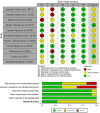Association between fluoride intake from drinking water and severity of dental fluorosis in Northern and Western Mexico: systematic review and meta-analysis
- PMID: 38898439
- PMCID: PMC11186227
- DOI: 10.1186/s12903-024-04472-7
Association between fluoride intake from drinking water and severity of dental fluorosis in Northern and Western Mexico: systematic review and meta-analysis
Abstract
Background: Dental fluorosis (DF) is caused by excessive exposure to fluoride during odontogenesis and leads to various changes in the development of tooth enamel. Some regions in Mexico are considered endemic fluorosis zones due to the high fluoride content in drinking water. The objective of this study was to perform a systematic review and meta-analysis to identify the association between the concentration of fluoride in drinking water and the severity of dental fluorosis in northern and western Mexico.
Methods: This protocol was registered in the PROSPERO database (ID: CRD42023401519). The search for information was carried out in the PubMed/Medline, Scopus, SpringerLink, and Google Scholar databases between January 2015 and October 2023. The overall relative risk was calculated using the inverse of variance approach with the random effects method. The RoB 2.0 tool was used to construct risk plots.
Results: Eleven articles were analyzed qualitatively, and most of the included studies presented at least one level of DF severity; six articles were analyzed quantitatively, dividing them into two regions. In North region it was observed a higher prevalence of severe TF cases, corresponding to ≥ TF 5 category (4.78) [3.55, 6.42]. In the West region, most of the included studies presented a higher prevalence of less severe cases, corresponding to ≤ TF 4, in comparison with the North region (0.01) [0.00, 0.52], interpreted as a protective effect.
Conclusion: The concentrations of fluorides in drinking water are reportedly high in these regions and are directly related to the severity of dental fluorosis experienced by the inhabitants. In the Northern region exists a major concentration of fluoride in drinking water compared with the Western region as well as a prevalence of higher severity cases of dental fluorosis.
Keywords: Dental fluorosis; Fluoride in drinking water; Northern and western Mexico.
© 2024. The Author(s).
Conflict of interest statement
The authors declare that they have no conflicts of interest.
The authors declare no competing interests.
Figures





Similar articles
-
Nutritional status and dental fluorosis among schoolchildren in communities with different drinking water fluoride concentrations in a central region in Mexico.Sci Total Environ. 2016 Jan 15;541:512-519. doi: 10.1016/j.scitotenv.2015.09.085. Epub 2015 Sep 29. Sci Total Environ. 2016. PMID: 26426374
-
Fluorosis and dental caries in Mexican schoolchildren residing in areas with different water fluoride concentrations and receiving fluoridated salt.Caries Res. 2013;47(4):299-308. doi: 10.1159/000346616. Epub 2013 Feb 13. Caries Res. 2013. PMID: 23406606
-
An inverse relationship between dental fluorosis and Molar Incisor Hypomineralization in Mexican schoolchildren in an area with a high concentration of fluoride in drinking water: A cross-sectional study.PLoS One. 2024 Sep 16;19(9):e0310420. doi: 10.1371/journal.pone.0310420. eCollection 2024. PLoS One. 2024. PMID: 39283869 Free PMC article.
-
Fluoride concentration in ground water and prevalence of dental fluorosis in Ethiopian Rift Valley: systematic review and meta-analysis.BMC Public Health. 2019 Oct 16;19(1):1298. doi: 10.1186/s12889-019-7646-8. BMC Public Health. 2019. PMID: 31619212 Free PMC article.
-
National and sub-national drinking water fluoride concentrations and prevalence of fluorosis and of decayed, missed, and filled teeth in Iran from 1990 to 2015: a systematic review.Environ Sci Pollut Res Int. 2016 Mar;23(6):5077-98. doi: 10.1007/s11356-016-6160-0. Epub 2016 Feb 3. Environ Sci Pollut Res Int. 2016. PMID: 26841772
Cited by
-
Influence of Behavioral and Sociodemographic Factors on Dental Caries in Mexican Children.Pediatr Rep. 2025 Mar 26;17(2):40. doi: 10.3390/pediatric17020040. Pediatr Rep. 2025. PMID: 40278520 Free PMC article.
References
-
- Rojanaworarit C, Claudio L, Howteerakul N, Siramahamongkol A, Ngernthong P, Kongtip P, Woskie S. Hydrogeogenic fluoride in groundwater and dental fluorosis in Thai agrarian communities: a prevalence survey and case–control study. BMC Oral Health. 2021;21(1):545. doi: 10.1186/s12903-021-01902-8. - DOI - PMC - PubMed
-
- Jarquín-Yañez L, de Jesús Mejía-Saavedra J, Molina-Frechero N, Gaona E, Rocha-Amador DO, López-Guzmán OD, Bologna-Molina R. Association between urine fluoride and dental fluorosis as a toxicity factor in a rural community in the state of San Luis Potosi. Scient World J. 2015; 2015:648174. 10.1155/2015/647184. - PMC - PubMed
Publication types
MeSH terms
Substances
LinkOut - more resources
Full Text Sources
Medical
Miscellaneous

